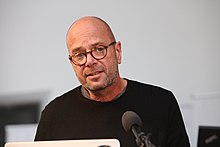
Martin Arnold (born 1959 in Vienna, Austria) is an experimental filmmaker known for his obsessive deconstruction of found footage. [1]

Martin Arnold (born 1959 in Vienna, Austria) is an experimental filmmaker known for his obsessive deconstruction of found footage. [1]
Arnold's films are intensely cut sequences in which several seconds of old movie clips are taken and stretched out into much longer works. The figures on the screen flip back and forth between frames, as the motion is repeated and reversed, and numerous single frame cuts are made. His intent is to create, or possibly unearth, narratives concealed within the mundane films from which he samples. In films such as Pièce Touchée (1989) and Passage à l'acte (1993) [2] for example he uses several seconds of the films The Human Jungle and To Kill a Mockingbird, [3] the latter to create a bizarre story of aggression and tension within a traditional American family. [4]
In a later group of short film loops such as Soft Palate (2010) and Whistle Stop (2014), [5] Arnold seems to discover psychoanalytic underbellies in the most popular form of post-war family entertainment, animation, and its most iconic characters such as Mickey Mouse (using two of Mickey's shorts, one of them Mickey's Delayed Date ), Tom And Jerry, Daffy Duck ( Draftee Daffy ) and Goofy (How To Play Golf).
His work has been shown at 168 international film festivals, including Cannes, Rotterdam and New York. At these festivals he has won 34 awards, such as the Golden Gate Award at the San Francisco International Film Festival (1990), the Primo Premio at the Arco Madrid's Week of Experimental Cinema (1994) and the Main Award at the International Short Film Festival Oberhausen (1998). For his entire oeuvre he was awarded for Honors for Art in Cinema by the State of Austria (1994) and the Province of Lower Austria (1995). In addition to festival screenings, Arnolds's films have been shown at various cinematheques such as the Cinematheque in Paris, the Cinematheque Royale in Brussels, the National Film Theatre in London, the San Francisco Cinematheque, and the Cinematheque of the MoMA in NYC. Arnold's work was also included in museum exhibitions at places such as the Witte de With in Rotterdam, the Bozar in Brussels, the Barbican Art Center in London, the Kunsthaus Zürich and the Hamburger Kunstverein, among others. Essays on his work and at-length interviews have appeared in several film and art magazines including Afterimage, Film Quarterly, Frieze Magazine, Cahiers du Cinéma, and Semiotiques, and in catalogues and books such as Martin Arnold – Gross Anatomies [6] by Martin Janda [7] and Martin Arnold – Deanimated [8] by Gerald Matt and Thomas Miessgang, A Critical Cinema 3 by Scott MacDonald, L’Art du mouvement by Jean-Michel Bohours for the Centre Georges Pompidou. Reviews of his film and installation works were published in numerous papers including The New York Times, The Village Voice, The Chicago Weekly Reader, L. A. Weekly, The Guardian, Le Monde, La Liberation and Die Neue Zürcher Zeitung.
He taught at several American universities and art schools such as the University of Wisconsin, Milwaukee (1995), the San Francisco Art Institute (1996/97), Bard College (2000/01), Binghamton University (2004–2007) and CalArts (2008). In Europe Arnold had guest professorships at the Städelschule in Frankfurt (1999), the FAMU in Prague (2009/10) and the University of Art and Design in Linz (1998).
2014
2013
2011
2010
2007
2005
2003
2002
1998
1997
1996
1994
1993
1989

A silent film is a film without synchronized recorded sound. Though silent films convey narrative and emotion visually, various plot elements or key lines of dialogue may, when necessary, be conveyed by the use of inter-title cards.

Super 8 mm film is a motion-picture film format released in 1965 by Eastman Kodak as an improvement over the older "Double" or "Regular" 8 mm home movie format.
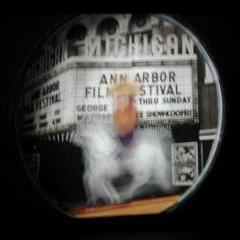
The Ann Arbor Film Festival is an annual film festival held in Ann Arbor, Michigan. Established in 1963, it is the fourth-oldest film festival in North America and the oldest experimental film festival. It has become one of the premier film festivals for independent and, especially, experimental filmmakers to showcase their work. The Ann Arbor Film Festival attracts over 3,000 entries from filmmakers in more than 60 countries, and distributes over $20,000 in cash awards. As an early example of the traveling festival concept beginning in 1964, each year the Ann Arbor Film Festival Tour presents a collection of short films at more than 30 art house theaters, universities, galleries and cinematheques throughout the world.
The UCLA Film & Television Archive is a visual arts organization focused on the preservation, study and appreciation of film and television, based at the University of California, Los Angeles (UCLA).
The Melbourne Cinémathèque is a non-profit membership-based film society screening programs year-round, dedicated to presenting the history of world cinema on the big screen in carefully curated retrospectives. It screens at ACMI in Melbourne.

Ken Jacobs is an American experimental filmmaker. His style often involves the use of found footage which he edits and manipulates. He has also directed films using his own footage.
The American Cinematheque is an independent, non-profit cultural organization in Los Angeles, California, United States dedicated exclusively to the public presentation of the moving image in all its forms.
Fred Worden, filmmaker, has been involved in experimental cinema since the 1970s. His work has been screened at The Museum of Modern Art, in the 2002 Whitney Biennial, The Centre Pompidou, in Paris, The Pacific Film Archive, The New York Film Festival, The London Film Festival, The Rotterdam International Film Festival, The Toronto Film Festival, and The Hong Kong International Film Festival. He was an editor for Criss-Cross Art Communications from the '70s through the '80s and his writings have appeared in Cinematograph. His work is included in the Stan Brakhage Collection, the Austrian Museum, The Centre Pompidou and others. Worden's work develops out of his interest in intermittent projection as the source of cinema's primordial powers: how a stream of still pictures passing through a projector at a speed meant to overwhelm the eyes might be harnessed to purposes other than representation or naturalism.
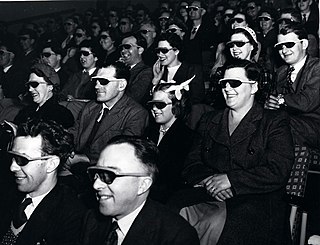
The Telecinema was a small cinema built especially for the Festival of Britain's London South Bank Exhibition in the summer of 1951. It was situated between Waterloo station and the Royal Festival Hall.
Peggy Ahwesh is an American experimental filmmaker and video artist. She received her B.F.A. at Antioch College. A bricoleur who has created both narrative works and documentaries, some projects are scripted and others incorporate improvised performance. She makes use of sync sound, found footage, digital animation, and Pixelvision video. Her work is primarily an investigation of cultural identity and the role of the subject in various genres. Her interests include genre; women, sexuality and feminism; reenactment; and artists' books. Her works have been shown worldwide, including in San Francisco, New York, Barcelona, London, Toronto, Rotterdam, and Créteil, France. Starting in 1990, she has taught at Bard College as a Professor of Film and Electronic Arts. Her teaching interests include: experimental media, history of the non-fiction film, and women in film.
The Cleveland Institute of Art Cinematheque is an alternative and repertory film theatre located in the University Circle neighborhood of Cleveland, Ohio.
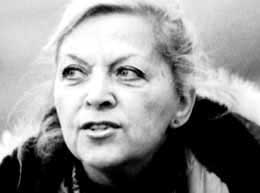
Storm de Hirsch (1912–2000) was an American poet and filmmaker. She was a key figure in the New York avant-garde film scene of the 1960s, and one of the founding members of the Film-Makers' Cooperative. Although often overlooked by historians, in recent years she has been recognized as a pioneer of underground cinema.
Richard Roger Reeves is a Canadian animated filmmaker. He is known for his whimsical abstract animated films created using a drawn on film technique.

Steven Woloshen is a Canadian film animator and a pioneer of drawn-on-film animation.
Luther Price (pseudonym) was an experimental filmmaker and visual artist.

The Cinematheque, founded in 1972, is a Canadian charity and non-profit film institute, media education centre, and film exhibitor based in Vancouver, British Columbia.

Andrej Zdravič is a Slovenian independent filmmaker, sound and media artist. He was educated in Ljubljana, Algiers and Buffalo, receiving his BA (1975) and MA degrees (1980) in Media Studies at the State University of New York, Buffalo. He was awarded a Slovenian Prešeren Foundation Award in 1999 and received an honorary award for artistic achievement from University of Ljubljana in 2006.
American artist Joseph Cornell (1903–1972) is justifiably best known for his boxes which constitute a singular contribution to the Surrealist canon and to the art of assemblage. However, he also pursued experimental film-making as an amateur beginning in the 1930s. Cornell was the principal pioneer of collage films in a purely artistic sense and, although the introduction of his films into the public forum was relatively late compared to when they were made, his work as a filmmaker has been widely influential.
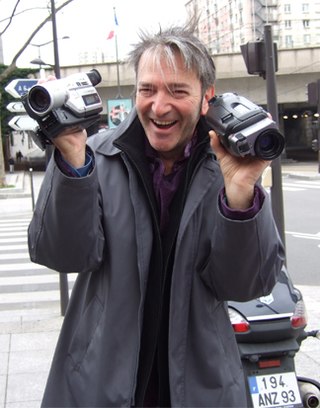
Jean-Claude Mocik, was born on February 9, 1958, in Livry Gargan. He is a filmmaker, video director, a director and teacher.

The Afterlight is a 2021 British experimental supercut art film directed and assembled by Charlie Shackleton.